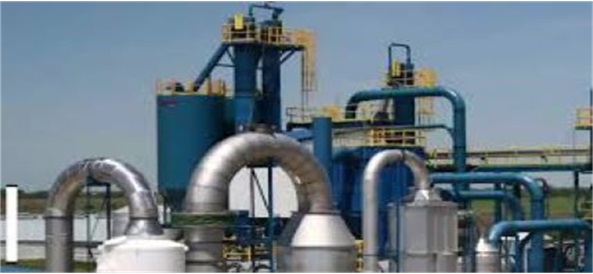Why in the NEWS?
- Finance Minister Nirmala Sitharaman announced setting up of a new urea plant with an annual production capacity of 12.7 lakh tonnes at Namrup in Assam.

What will you read next in this topic?
- About Urea Plants in India.
- Urea: Important Fertilizer in Agriculture
- Structure and manufacturing of urea:
- Uses of Urea in Agriculture:
- Benefits of Urea in Agriculture:
- Liquid Urea and Nano Urea
- Neem Coated Urea
- Effect of urea on the environment:
About Urea Plants in India.
- A new urea plant has been proposed to be set up in the Union Budget 2025, which will be the eighth new urea plant to come up in India since 2019.
- Six urea plants have been commissioned between January 2019 and November 2022:
- Gapepan (Rajasthan)
- Ramagundam (Telangana)
- Panagarh (West Bengal)
- Gorakhpur (Uttar Pradesh)
- Barauni (Bihar)
- Sindhri (Jharkhand)
- The total capacity of these plants is 12.7 lakh metric tonnes.
- The seventh plant at Talcher (Odisha) is under construction, which is about 65% complete.
- This plant will use coal as feedstock, while the other plants will be based on natural gas.
- Most of the plants will use natural gas, which is imported.
- There are seven liquefied natural gas (LNG) terminals set up in India:
- Mundra, Dahej and Hazira (Gujarat)
- Kochi (Kerala)
- Ennore (Tamil Nadu)
- Dhamra (Odisha)
- The gas will be transported to the interior of the country through these terminals and pipelines.
- India's domestic urea production is projected to increase from 22 million tonnes in 2011-12 to 31.4 million tonnes in 2023-24.
- Urea imports have declined by 28.9% in the current financial year (April-December).
- Urea imports have declined from 6.1 million tonnes to 4.3 million tonnes in the same period of 2023-24.
- The government aims to achieve self-sufficiency in urea as it is the most consumed fertilizer in India.
Urea: Important Fertilizer in Agriculture
- Urea is an extremely important chemical fertilizer, which is especially used in agriculture as a nitrogen-based fertilizer.
- It is the most common and major source of nitrogen, which is extremely essential for plant growth.
- It is the most widely used substance as a fertilizer all over the world.
Structure and manufacturing of urea:
Chemical structure:
- The chemical formula of urea is (NH₂)₂CO.
- This means that urea consists of two ammonia (NH₃) molecules and one carbon dioxide (CO₂) molecule.
Manufacturing process:
- Urea is mainly manufactured by combining ammonia and carbon dioxide.
- This process usually takes place under high temperature and pressure, which is required for the manufacture of urea.
- Urea is obtained as a colourless and crystalline substance.
Uses of Urea in Agriculture:
- Urea is used as a fertilizer in the agricultural sector.
- It contains high nitrogen content (46%), which is highly important for the growth and development of plants.
- Using urea effectively increases the production of crops and also improves their quality.
Benefits of Urea in Agriculture:
Major Source of Nitrogen:
- Urea contains high amount of nitrogen, which is one of the most important nutrients for plants.
- Nitrogen is the life-giving element for plants, which helps in the growth of their green leaves, stems and flowers.
Helpful in plant growth:
- The presence of nitrogen increases the size of plant leaves and improves their green colour.
- It promotes the growth of leaves and stems, which leads to higher crop production.
Formation of flowers and fruits:
- The use of urea also promotes the production of flowers and fruits of crops.
- Using urea in the right amount improves the quality and size of fruits, which also improves the sale of agricultural products.
Liquid Urea and Nano Urea
Liquid Urea:
- Liquid urea is the liquid form of urea which is a major source of nitrogen.
- It is commonly used in agriculture, especially in places where the use of solid urea is difficult or not favourable.
- It is a soluble form of urea, so that it can be easily mixed in water and delivered directly to the roots of the plants.
Main benefits of liquid urea:
- Easily dissolved in water:
- Liquid urea dissolves easily in water, so that it can be mixed with the soil quickly and effectively.
- Uniform distribution:
- Urea is sprayed in liquid form, which ensures uniform distribution of fertilizer and delivers nitrogen to every part of the crop.
- Water saving:
- Due to its liquid form, urea is used by mixing it with water, which helps in maintaining moisture in the soil and saves water.
- Biodegradable:
- Liquid urea has a natural low impact on the soil and the environment.
Nano Urea:
- Nano Urea is a new and innovative form of urea, developed through nanotechnology.
- In this, the urea molecules are shaped into Nano size, so that it can be absorbed by plants in a more effective way.
- This not only increases the effectiveness of urea, but also has less negative impact on the environment.
Key Benefits of Nano Urea:
- High absorption rate:
- Nano-sized molecules of Nano urea are easily absorbed by plants, which leads to better use of nitrogen and can reduce its quantity.
- Less environmental impact:
- The use of Nano urea has less negative impact on the environment than conventional urea, as it reduces leakage and evaporation of nitrogen.
- Effective in less quantity:
- An important advantage of Nano urea is that it can be used in smaller quantities, which reduces the cost of fertilizer and also reduces environmental pressure.
- Better water management:
- It helps in maintaining water availability in the soil, as Nano Urea is absorbed slowly by the plants.
- Better Nitrogen Utilization:
- Use of Nano Urea ensures maximum availability of nitrogen, leading to improved plant growth and production.
Neem Coated Urea
- It is a type of fertilizer prepared by coating neem oil or neem skin in urea.
- It is an organic and eco-friendly fertilizer that aims to make the use of urea more effective and sustainable.
- This fertilizer is not only beneficial for farmers, but it also reduces environmental side effects.
Benefits of Neem Coated Urea:
- Slow supply of nitrogen:
- Neem coated urea releases nitrogen from urea slowly.
- This provides a constant and controlled flow of nitrogen to the plants, improving their growth and preventing excessive consumption of urea.
- Climate and environment friendly:
- Neem coated urea has less volatilization and leaching of nitrogen as compared to normal urea.
- It causes less harm to the environment as it improves the absorption of nitrogen in water and soil.
- Increased Nitrogen Absorption Capacity:
- Neem oil has anti-bacterial properties, which control the growth of bacteria present in the soil, leading to better nitrogen absorption capacity.
- Better Crop Growth:
- Neem coated urea enhances the growth of crops and strengthens their roots.
- It gives good results especially in crops like sugarcane, rice, wheat, maize, and pulses.
- Insecticidal Properties:
- Neem has naturally occurring insecticidal properties, which helps in controlling pests and diseases.
- It provides natural protection to the crops.
- Improves Soil Quality:
- Neem coated urea helps in improving the soil structure and quality, ensuring long-term agricultural production.
- Uses of Neem Coated Urea:
- Neem coated urea is used in the same way as normal urea, but at a slower rate.
- Hence, it can be effectively used for a longer period of time as per the specific requirement of the crops.
- It is mixed directly into the soil or spread over the field.
Effect of urea on the environment:
- Although urea is extremely beneficial for plants, its excessive and incorrect use can have a negative impact on the environment.
- Excessive application of urea leads to over-emission of nitrogen, which may cause climate change, soil pollution and water pollution.
Nitrogen imbalance in soil:
- Excessive use of urea may cause nitrogen imbalance in the soil, which leads to deterioration in soil quality and also affects crop production.
Water pollution:
- Excessive use of urea may leach into water sources, causing water pollution and increase in nitrate levels, which may pose a threat to human health.
Greenhouse gas emission:
- Excessive use of urea may increase the emission of greenhouse gases (mainly nitrous oxide), which causes global warming.
|
Q. How much did India's urea imports decrease during 2023-24?
(a) 28.9%
(b) 15%
(c) 40%
(d) 10%
|



